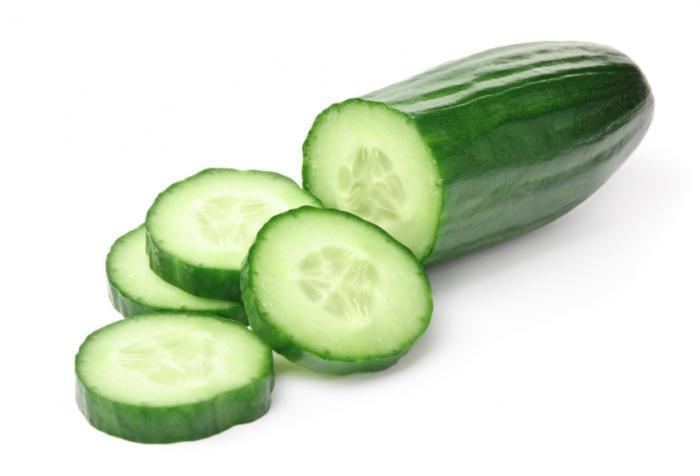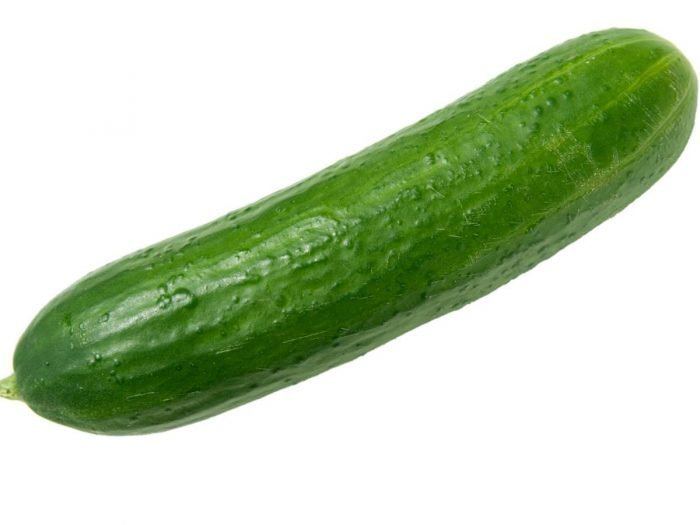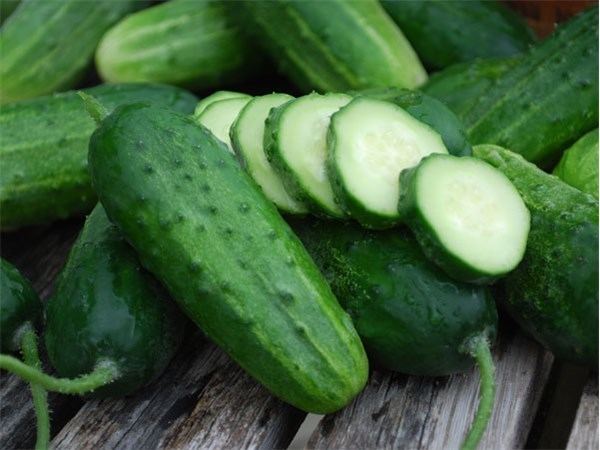Kingdom Plantae Family Cucurbitaceae Species C. sativus | Order Cucurbitales Genus Cucumis | |
 | ||
Similar Trichosanthes dioica, Watermelon, Muskmelon | ||
Dry cucumber vegetable prashant damle menus of maharashtra
Cucumber (Cucumis sativus) is a widely cultivated plant in the gourd family, Cucurbitaceae. It is a creeping vine that bears cucumiform fruits that are used as vegetables. There are three main varieties of cucumber: slicing, pickling, and seedless. Within these varieties, several cultivars have been created. In North America, the term "wild cucumber" refers to plants in the genera Echinocystis and Marah, but these are not closely related. The cucumber is originally from South Asia, but now grows on most continents. Many different types of cucumber are traded on the global market.
Contents
- Dry cucumber vegetable prashant damle menus of maharashtra
- Cucumber vegetable rhyme
- Description
- Flowering and pollination
- Genome
- Production
- Nutrition
- Varieties
- Slicing
- Pickling
- Burpless
- Aroma and taste
- Cultivation history
- Earliest cultivation
- Roman Empire
- Middle Ages
- Early modern age
- Age of Enlightenment and later
- In the news
- References

Cucumber vegetable rhyme
Description

The cucumber is a creeping vine that roots in the ground and grows up trellises or other supporting frames, wrapping around supports with thin, spiraling tendrils. The plant may also root in a soilless medium and will sprawl along the ground if it does not have supports. The vine has large leaves that form a canopy over the fruits. The fruit of typical cultivars of cucumber is roughly cylindrical, but elongated with tapered ends, and may be as large as 60 centimeters (24 in) long and 10 centimeters (3.9 in) in diameter. Botanically speaking, the cucumber is classified as a pepo, a type of botanical berry with a hard outer rind and no internal divisions. Much like tomato and squash, it is often perceived, prepared and eaten as a vegetable. Cucumber fruits are usually more than 90% water.
Flowering and pollination

A few cultivars of cucumber are parthenocarpic, the blossoms creating seedless fruit without pollination. Pollination for these cultivars degrades the quality. In the United States, these are usually grown in greenhouses, where bees are excluded. In Europe, they are grown outdoors in some regions, and bees are excluded from these areas.
Most cucumber cultivars, however, are seeded and require pollination. Thousands of hives of honey bees are annually carried to cucumber fields just before bloom for this purpose. Cucumbers may also be pollinated by bumblebees and several other bee species. Most cucumbers that require pollination are self-incompatible, so pollen from a different plant is required to form seeds and fruit. Some self-compatible cultivars exist that are related to the 'Lemon' cultivar. Symptoms of inadequate pollination include fruit abortion and misshapen fruit. Partially pollinated flowers may develop fruit that are green and develop normally near the stem end, but are pale yellow and withered at the blossom end.

Traditional cultivars produce male blossoms first, then female, in about equivalent numbers. Newer gynoecious hybrid cultivars produce almost all female blossoms. They may have a pollenizer cultivar interplanted, and the number of beehives per unit area is increased, but temperature changes induce male flowers even on these plants, which may be sufficient for pollination to occur.
Genome
In 2009, an international team of researchers announced they had sequenced the cucumber genome.
Production
According to the Food and Agriculture Organization of the United Nations for cucumber and gherkin production in 2013, China produced 76% of the global output, followed by Turkey, Iran, Russia and Ukraine (table).
Nutrition
In a 100 gram serving, raw cucumber (with peel) is 95% water, provides 16 calories and supplies low content of essential nutrients, as it is notable only for vitamin K at 16% of the Daily Value (table).
Varieties
In general cultivation, cucumbers are classified into three main cultivar groups: "slicing", "pickling", and "burpless".
Slicing
Cucumbers grown to eat fresh are called slicing cucumbers. The main varieties of slicers mature on vines with large leaves that provide shading. They are mainly eaten in the unripe green form, since the ripe yellow form normally becomes bitter and sour. Slicers grown commercially for the North American market are generally longer, smoother, more uniform in color, and have a much tougher skin. Slicers in other countries are smaller and have a thinner, more delicate skin. Smaller slicing cucumbers can also be pickled.
Pickling
Cucumbers can be pickled for flavor and longer shelf-life. Although any cucumber can be pickled, commercial pickles are made from cucumbers specially bred for uniformity of length-to-diameter ratio and lack of voids in the flesh. Those cucumbers intended for pickling, called picklers, grow to about 7 cm (3 in) to 10 cm (4 in) long and 2.5 cm (1 in) wide. Compared to slicers, picklers tend to be shorter, thicker, less regularly shaped, and have bumpy skin with tiny white or black-dotted spines. They are never waxed. Color can vary from creamy yellow to pale or dark green. Pickling cucumbers are sometimes sold fresh as “Kirby” or “Liberty” cucumbers. Pickled cucumbers are soaked in brine or a combination of vinegar and brine, although not vinegar alone, often along with various spices. Pickled cucumbers are called "pickles" in the US or "gherkins" or "wallies" in the UK, the latter name being more common in the north of England and London, where it refers to the large vinegar-pickled cucumbers commonly sold in fish and chip shops.
Burpless
Burpless cucumbers are sweeter and have a thinner skin than other varieties of cucumber, and are reputed to be easy to digest and to have a pleasant taste. They can grow as long as 2 feet (0.61 m). They are nearly seedless, and have a delicate skin. Most commonly grown in greenhouses, these parthenocarpic cucumbers are often found in grocery markets, shrink-wrapped in plastic. They are sometimes marketed as seedless or burpless, because the seeds and skin of other varieties of cucumbers are said to give some people gas.
Several other cultivars are sold commercially:
Aroma and taste
Most people report a mild, almost watery or light melon aroma and flavor of cucumbers resulting from compounds called (E,Z)-nona-2,6-dienal, (Z)-2-nonenal and (E)-2-nonenal. The slightly bitter taste of cucumbers results from cucurbitacins.
Cultivation history
The cucumber originated in India, where a great many varieties have been observed, from Cucumis hystrix. It has been cultivated for at least 3,000 years, and was probably introduced to other parts of Europe by the Greeks or Romans. Records of cucumber cultivation appear in France in the 9th century, England in the 14th century, and in North America by the mid-16th century.
Earliest cultivation
The cucumber is listed among the foods of ancient Ur, and the legend of Gilgamesh describes people eating cucumbers. Some sources also state it was produced in ancient Thrace, and it is certainly part of modern cuisine in Bulgaria and Turkey, parts of which make up that ancient state. Cucumbers are mentioned in the Bible as one of the foods eaten by the Israelites in Egypt. From India, it spread to Greece (where it was called "σίκυον", síkyon) and Italy (where the Romans were especially fond of the crop), and later into China.
Robert Daniel, in discussing an ostracon dated to the second half of the third century AD, has suggested identifying an otherwise unknown word, ολγιττα, with the Arabic al-qitta', the common word for cucumber.
According to Pliny the Elder (The Natural History, Book XIX, Chapter 23), the Ancient Greeks grew cucumbers, and there were different varieties in Italy, Africa, and Moesia.
Roman Empire
According to Pliny, the Emperor Tiberius had the cucumber on his table daily during summer and winter. The Romans reportedly used artificial methods (similar to the greenhouse system) of growing to have it available for his table every day of the year. "Indeed, he was never without it; for he had raised beds made in frames upon wheels, by means of which the cucumbers were moved and exposed to the full heat of the sun; while, in winter, they were withdrawn, and placed under the protection of frames glazed with 'mirrorstone' ." 'Mirrorstone' is a literal translation of Pliny's 'lapis specularis', believed to have been sheet mica.
Reportedly, they were also cultivated in cucumber houses glazed with oiled cloth known as “specularia”.
Pliny the Elder describes the Italian fruit as very small, probably like a gherkin, describing it as a wild cucumber considerably smaller than the cultivated one. Pliny also describes the preparation of a medication known as elaterium, though some scholars believe he was referring to Ecballium elaterium, known in pre-Linnean times as "Cucumis silvestris" or "Cucumis asininus" ("wild cucumber" or "donkey cucumber"), a species different from the common cucumber. Pliny also writes about several other varieties of cucumber, including the cultivated cucumber, and remedies from the different types (9 from the cultivated, 5 from the "anguine", and 26 from the "wild"). The Romans are reported to have used cucumbers to treat scorpion bites, bad eyesight, and to scare away mice. Wives wishing for children wore them around their waists. They were also carried by midwives, and thrown away when the child was born.
Middle Ages
Charlemagne had cucumbers grown in his gardens in the 8th/9th century. They were reportedly introduced into England in the early 14th century, lost, then reintroduced approximately 250 years later. The Spaniards (through the Italian Christopher Columbus) brought cucumbers to Haiti in 1494. In 1535, Jacques Cartier, a French explorer, found “very great cucumbers” grown on the site of what is now Montreal.
Early-modern age
Throughout the 16th century, European trappers, traders, bison hunters, and explorers bartered for the products of American Indian agriculture. The tribes of the Great Plains and the Rocky Mountains learned from the Spanish how to grow European crops. The farmers on the Great Plains included the Mandan and Abenaki. They obtained cucumbers and watermelons from the Spanish, and added them to the crops they were already growing, including several varieties of corn and beans, pumpkins, squash, and gourd plants. The Iroquois were also growing them when the first Europeans visited them.
In 1630, the Reverend Francis Higginson produced a book called New England’s Plantation in which, describing a garden on Conant’s Island in Boston Harbor known as The Governor’s Garden, he states: “The countrie aboundeth naturally with store of roots of great varietie and good to eat. Our turnips, parsnips, and carrots are here both bigger and sweeter than is ordinary to be found in England. Here are store of pompions, cowcumbers, and other things of that nature which I know not...”
William Wood published in New England Prospect (published in 1633 in England) observations he made in 1629 in America: “The ground affords very good kitchin gardens, for Turneps, Parsnips, Carrots, Radishes, and Pompions, Muskmillons, Isquoter-squashes, coucumbars, Onyons, and whatever grows well in England grows as well there, many things being better and larger.”
Age of Enlightenment and later
In the later 17th century, a prejudice developed against uncooked vegetables and fruits. A number of articles in contemporary health publications stated that uncooked plants brought on summer diseases and should be forbidden to children. The cucumber kept this reputation for an inordinate period of time: “fit only for consumption by cows,” which some believe is why it gained the name, cowcumber.
A copper etching made by Maddalena Bouchard between 1772 and 1793 shows this plant to have smaller, almost bean-shaped fruits, and small yellow flowers. The small form of the cucumber is figured in Herbals of the 16th century, but states, "If hung in a tube while in blossom, the Cucumber will grow to a most surprising length."
Samuel Pepys wrote in his diary on 22 August 1663: “this day Sir W. Batten tells me that Mr. Newburne is dead of eating cowcumbers, of which the other day I heard of another, I think.” In "The Greenstone Door", William Satchell notes that "Te Moanaroa was dead – of a surfeit of cucumbers...", having eaten four of the "prickly" melons. (Chapter XX, The Storm Cloud).
In the news
In May 2011, cucumbers infected with E. coli were claimed to have caused the deaths of at least ten people, leading to some retailers withdrawing cucumbers from sale in Germany, Austria and the Czech Republic. The cucumbers were initially thought to have come from Spain. However, subsequent testing failed to show contamination in imported Spanish cucumbers, which led to the Spanish Government demanding compensation for Spanish farmers who had been forced to destroy huge quantities of cucumbers.
After the outbreak, the World Health Organization stated that it was a completely new strain of the bacterium involved.
